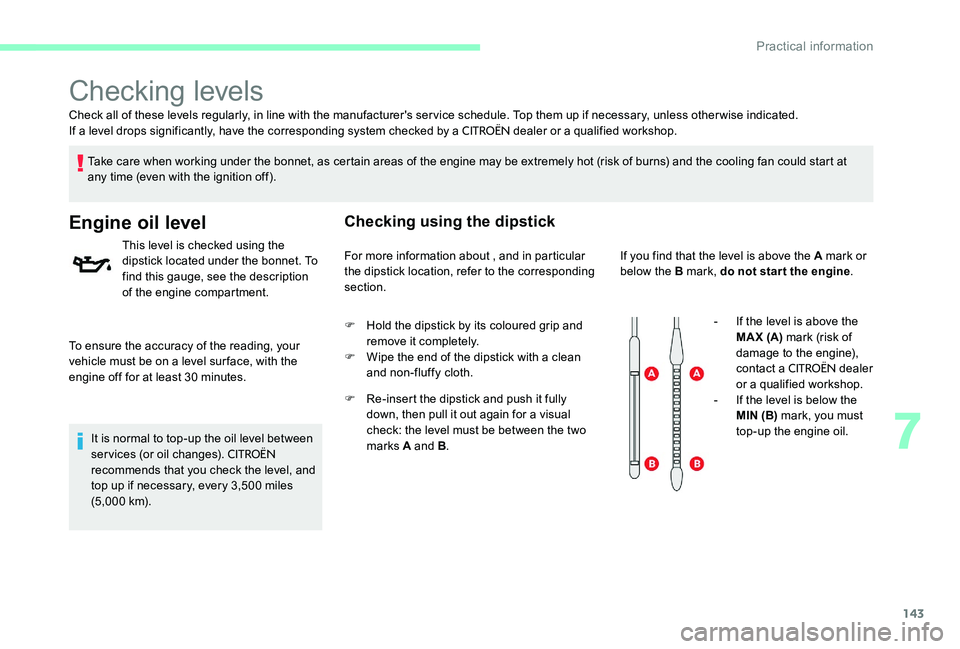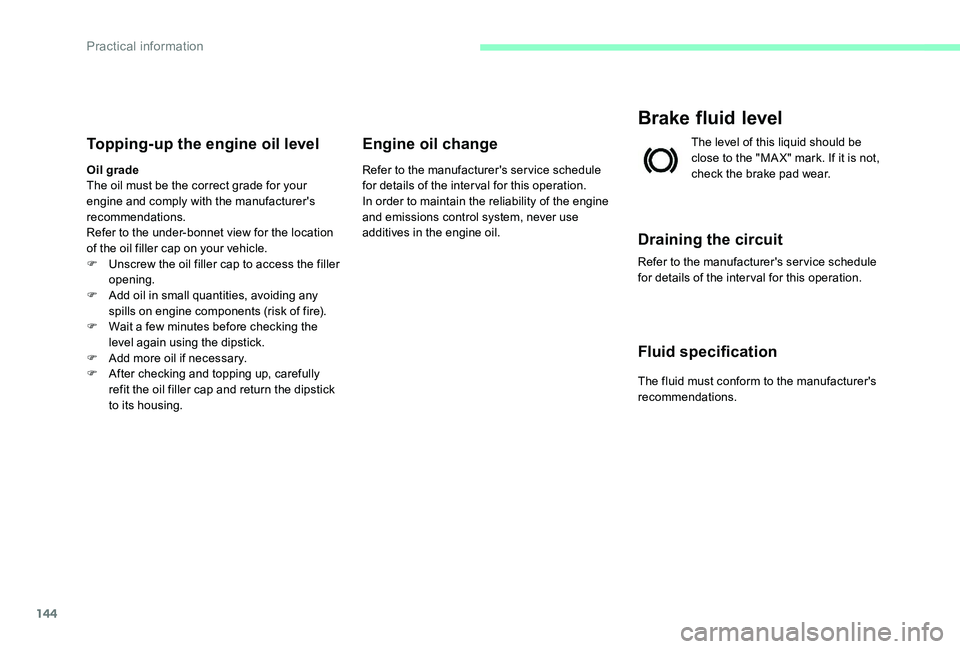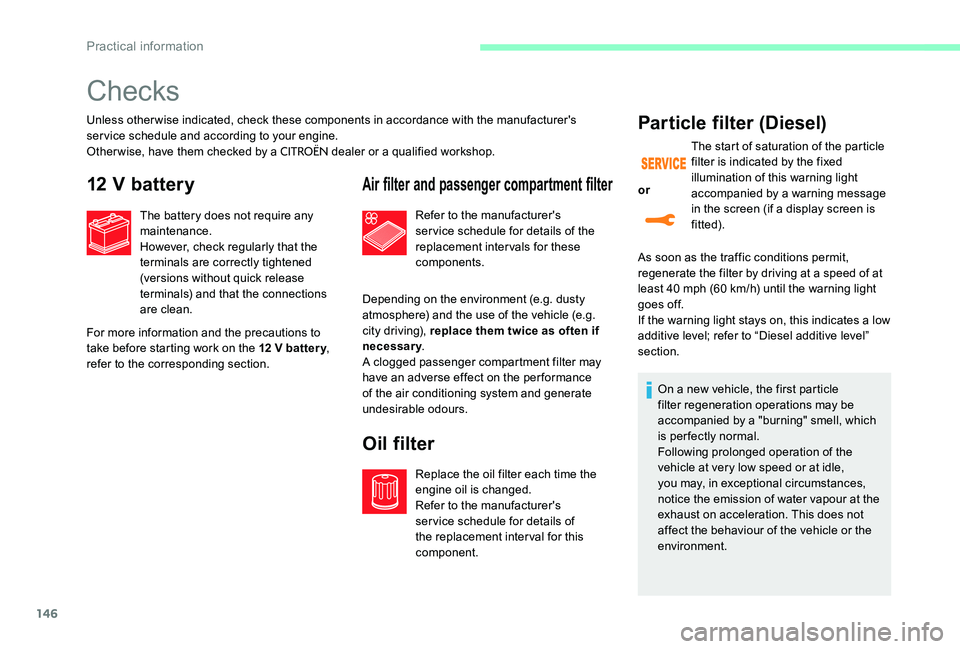service CITROEN C-ELYSÉE 2017 Handbook (in English)
[x] Cancel search | Manufacturer: CITROEN, Model Year: 2017, Model line: C-ELYSÉE, Model: CITROEN C-ELYSÉE 2017Pages: 306, PDF Size: 9.34 MB
Page 78 of 306

76
Malfunction
or
With the touch screen
F Press the ‘7’ or ‘ 8’ button to select ‘ Ty r e
pressures ’, then "Reinitialisation ", then
confirm by pressing the central button.
A message confirms the reset operation. Press MENU
.
In the Driving / Vehicle
menu, select "
Under-inflation
initialisation ".
Press " Ye s" to Confirm the request,
a sound signal and a message
confirm the reset operation.
The under-inflation alert can only be relied
on if the reinitialisation of the system has
been done with the pressures in the four
tyres correctly adjusted.
Snow chains
The system does not have to be
reinitialised after fitting or removing snow
chains. The flashing and then fixed illumination of the
under-inflation warning light accompanied
by illumination of the Service warning light
indicates a fault with the system.
A message appears, accompanied by an
audible signal.
In this case, under-inflation monitoring of the
tyres is no longer provided.
Have the system checked by a
CITROËN dealer
or a qualified workshop.
After carrying out any work on the system,
the pressure of the four tyres must be
checked and the system reinitialised.
Safety
Page 130 of 306

TOTAL & CITROËN
Par tners in per formance and protecting the
environment
Innovation in the search for per formance
For over 40 years, TOTAL Research and
Development teams have developed lubricants for
CITROËN, matching the latest technical innovations
on CITROËN vehicles, both in competition and
everyday motoring.
This guarantees that you will obtain the best
performance from your engine.
Optimum protection for your engine
By having your
CITROËN vehicle
serviced with TOTAL lubricants, you
are helping to improve the life and
per formance of your engine, while also
protecting the environment.
Page 134 of 306

132
AdBlue® and SCR system for BlueHDi Diesel engines
Using a fluid called AdBlue® containing urea, a
catalytic converter turns up to 85% of nitrogen
oxides (NOx) into nitrogen and water, which are
harmless to health and the environment.
The AdBlue
® is contained in a specific tank
of approximately 17 litres. Its capacity allows
a driving range of around 12,500 miles
(20,000
km). An alert system is triggered
automatically once the reserve level is reached:
you can then drive for a further 1,500 miles
(2,400 km) before the tank is empty.
During each scheduled service of your vehicle
by a
CITROËN dealer or a qualified workshop,
the AdBlue® tank is refilled in order to allow
normal operation of the SCR system. If the estimated mileage of your vehicle
between two services is greater than
12,500
miles (20,000 km), it will be necessary
to top-up the AdBlue
®.
Once the AdBlue
® tank is empty, a system
required by regulations prevents starting
of the engine.
If the SCR system is faulty, the level of
emissions from your vehicle will no longer
meet the Euro 6 standard: your vehicle
becomes polluting.
In the event of a confirmed fault with the
SCR system, you must go to a
CITROËN
dealer or a qualified workshop as soon
as possible: after a running distance of
650 miles (1,100 km), a system will be
triggered automatically to prevent engine
starting.
In either case, a range indicator gives you
the distance you can travel before the
vehicle is immobilised.
SCR system
To assure respect for the environment and
conformity with the new Euro 6 emissions
standard, without adversely affecting the
per formance or fuel consumption of Diesel
engines,
CITROËN has taken the decision to
equip its vehicles with an effective system that
associates the SCR system (Selective Catalytic
Reduction) with a particle filter (FAP) for the
treatment of exhaust gases.
Practical information
Page 135 of 306

133
Topping-up the AdBlue®
Filling the AdBlue® tank is an operation
included in every routine service on your
vehicle by a
CITROËN dealer or a qualified
workshop.
Nevertheless, given the capacity of the tank, it
may be necessary to top-up the fluid between
services, more particularly if an alert (warning
lamps and a message) signals the requirement.
You can go to a
CITROËN dealer or a qualified
workshop.
If you envisage topping-up yourself, please
read the following warnings carefully.
Freezing of the AdBlue
®
AdBlue® freezes at temperatures below
around -11°C.
The SCR system includes a heater for the
AdBlue
® tank, allowing you to continue
driving in all weather conditions.
Precautions in use
AdBlue® is a urea-based solution. This liquid is
non-flammable, colourless and odourless (kept
in a cool area).
In the event of contact with the skin, wash the
affected area with soap and water. In the event
of contact with the eyes, wash (irrigate) the
eyes copiously under running water or with an
eye wash solution for at least 15 minutes. If
a burning sensation or irritation persists, get
medical attention.
If swallowed, immediately wash out the mouth
with clean water and then drink plenty of water.
In certain conditions (high ambient
temperature, for example), the risk of release of
ammonia cannot be excluded: do not inhale the
fluid. Ammonia vapour has an irritant effect on
mucous membranes (eyes, nose and throat).
Keep AdBlue
® out of the reach of children,
in its original container or bottle.
Never transfer AdBlue
® to another
container: it would lose its purity. Use only AdBlue
® fluid that meets the
ISO
22241 standard.
Never dilute AdBlue
® with water.
Never pour AdBlue® into the Diesel fuel
tank.
The supply in a non-drip container or bottle
simplifies topping-up. You can obtain 1.89 litre
(half a US gallon) bottles or 5 litre containers
from a
CITROËN dealer or a qualified workshop.
Never top-up from an AdBlue
® dispenser
reserved for heavy goods vehicles.
7
Practical information
Page 145 of 306

143
Check all of these levels regularly, in line with the manufacturer's service schedule. Top them up if necessary, unless other wise indicated.
If a level drops significantly, have the corresponding system checked by a CITROËN dealer or a qualified workshop.
Take care when working under the bonnet, as certain areas of the engine may be extremely hot (risk of burns) and the cooling fan could start at
any time (even with the ignition off).
Checking levels
Engine oil level
To ensure the accuracy of the reading, your
vehicle must be on a level sur face, with the
engine off for at least 30 minutes.
It is normal to top-up the oil level between
services (or oil changes).
CITROËN
recommends that you check the level, and
top up if necessary, every 3,500 miles
(5,000 km). This level is checked using the
dipstick located under the bonnet. To
find this gauge, see the description
of the engine compartment.
Checking using the dipstick
For more information about , and in particular
the dipstick location, refer to the corresponding
section.
F
H
old the dipstick by its coloured grip and
remove it completely.
F
W
ipe the end of the dipstick with a clean
and non-fluffy cloth.
F
R
e-insert the dipstick and push it fully
down, then pull it out again for a visual
check: the level must be between the two
marks A and B . If you find that the level is above the A mark or
below the B mark, do not star t the engine
.
-
I
f the level is above the
MA X (A) mark (risk of
damage to the engine),
contact a
CITROËN dealer
or a qualified workshop.
-
I
f the level is below the
MIN (B) mark, you must
top-up the engine oil.
7
Practical information
Page 146 of 306

144
Topping-up the engine oil level
Oil grade
The oil must be the correct grade for your
engine and comply with the manufacturer's
recommendations.
Refer to the under-bonnet view for the location
of the oil filler cap on your vehicle.
F
U
nscrew the oil filler cap to access the filler
opening.
F
A
dd oil in small quantities, avoiding any
spills on engine components (risk of fire).
F
W
ait a few minutes before checking the
level again using the dipstick.
F
A
dd more oil if necessary.
F
A
fter checking and topping up, carefully
refit the oil filler cap and return the dipstick
to its housing.
Engine oil change
Refer to the manufacturer's service schedule
for details of the interval for this operation.
In order to maintain the reliability of the engine
and emissions control system, never use
additives in the engine oil.
Brake fluid level
The level of this liquid should be
close to the "MA X" mark. If it is not,
check the brake pad wear.
Draining the circuit
Refer to the manufacturer's service schedule
for details of the interval for this operation.
Fluid specification
The fluid must conform to the manufacturer's
recommendations.
Practical information
Page 147 of 306

145
Coolant level
The check and top-up must only be done with
the engine cold.
A low coolant level presents a risk of serious
damage to your engine.
The coolant level should be close to the "MA X"
mark but should never exceed it.
If the level is close to or below the "MIN" mark,
it is essential to top-up.
When the engine is hot, the temperature of the
coolant is regulated by the fan.
In addition, as the cooling system is
pressurised, wait at least one hour after
switching off the engine before carrying out any
work.
To avoid the risk of scalding when you need to
top-up in an emergency, place a cloth around
the cap and unscrew the cap by two turns to
allow the pressure to drop.
Once the pressure has dropped, remove the
cap and top-up the level.Check the coolant level regularly.
It is normal to top up the fluid
between two services.
Fluid specification
The fluid must conform to the manufacturer's
recommendations.
The cooling fan may star t after
switching off the engine: take care
with articles and clothing that might be
caught by the fan blades.
Screenwash fluid level
Top up the level when necessary.
Fluid specification
For optimum cleaning and to avoid freezing,
this fluid must not be topped up or replaced
with plain water.
In wintry conditions, it is recommended that you
use an ethyl alcohol or methanol based fluid.
Diesel additive level (Diesel
engine with particle filter)
A low additive level is indicated by illumination
of the service warning light, accompanied by an
audible warning and a message in the screen
(if a display screen is fitted).
To p p i n g u p
This additive must be topped-up by a CITROËN
dealer or a qualified workshop without delay.
Used products
Avoid prolonged contact of used oil or
fluids with the skin.
Most of these fluids are harmful to health
or indeed very corrosive.
Do not discard used oil or fluids into
sewers or onto the ground.
Take used oil to a
CITROËN dealer or
a qualified workshop and dispose of in
the containers made available for this
purpose.
7
Practical information
Page 148 of 306

146
Checks
Unless otherwise indicated, check these components in accordance with the manufacturer's
service schedule and according to your engine.
Other wise, have them checked by a
CITROËN dealer or a qualified workshop.
12 V battery
For more information and the precautions to
take before starting work on the 12 V batter y,
refer to the corresponding section. The battery does not require any
maintenance.
However, check regularly that the
terminals are correctly tightened
(versions without quick release
terminals) and that the connections
are clean.
Air filter and passenger compartment filter
Depending on the environment (e.g. dusty
atmosphere) and the use of the vehicle (e.g.
city driving), replace them twice as often if
necessary
.
A clogged passenger compartment filter may
have an adverse effect on the per formance
of the air conditioning system and generate
undesirable odours. Refer to the manufacturer's
service schedule for details of the
replacement intervals for these
components.
Oil filter
Replace the oil filter each time the
engine oil is changed.
Refer to the manufacturer's
service schedule for details of
the replacement interval for this
component.
Particle filter (Diesel)
As soon as the traffic conditions permit,
regenerate the filter by driving at a speed of at
least 40 mph (60 km/h) until the warning light
goes off.
If the warning light stays on, this indicates a low
additive level; refer to “Diesel additive level”
section. or
The start of saturation of the particle
filter is indicated by the fixed
illumination of this warning light
accompanied by a warning message
in the screen (if a display screen is
fitted).
On a new vehicle, the first particle
filter regeneration operations may be
accompanied by a "burning" smell, which
is per fectly normal.
Following prolonged operation of the
vehicle at very low speed or at idle,
you may, in exceptional circumstances,
notice the emission of water vapour at the
exhaust on acceleration. This does not
affect the behaviour of the vehicle or the
environment.
Practical information
Page 149 of 306

147
Manual gearbox
The gearbox does not require any
maintenance (no oil change).
Refer to the manufacturer's service
schedule for the checking interval
for this component.
Electronic gearbox
The gearbox does not require any
maintenance (no oil change).
Refer to the manufacturer's service schedule
for the checking interval for this component.
Automatic gearbox
The gearbox does not require any
maintenance (no oil change).
Refer to the manufacturer's service
schedule for the checking interval
for this component.
Brake pads
Brake wear depends on the style
of driving, particularly in the case
of vehicles used in town, over short
distances. It may be necessary to
have the condition of the brakes
checked, even between vehicle
services.
Unless there is a leak in the circuit, a drop in
the brake fluid level indicates that the brake
pads are worn.
Brake disc wear
For information on checking brake
disc wear, contact a CITROËN dealer
or a qualified workshop.
Parking brake
If excessive travel or a loss of
effectiveness of this system is
noticed, the parking brake must
be checked, even between two
services.
Checking this system must be done by a
CITROËN dealer or a qualified workshop.
Only use products recommended by
CITROËN or products of equivalent quality
and specification.
In order to optimise the operation of units
as important as those in the braking
system,
CITROËN selects and offers very
specific products.
After washing the vehicle, dampness, or
in wintry conditions, ice can form on the
brake discs and pads: braking efficiency
may be reduced. Make light brake
applications to dry and defrost the brakes.
7
Practical information
Page 176 of 306

174
Charging the battery using
a battery charger
For optimum service life of the battery, it is
essential to maintain an adequate state of
charge.
In some circumstances it may be necessary to
charge the battery:
-
I
f you use your vehicle essentially for short
journeys.
-
I
f the vehicle is to be taken off the road for
several weeks.
Contact a
CITROËN dealer or a qualified
workshop.
If you envisage charging your vehicle's
battery yourself, use only a charger
compatible with lead-based batteries of a
nominal voltage of 12 V.
Follow the instructions for use provided by
the charger manufacturer.
Never reverse polarities.
It is not necessary to disconnect the
battery. F
S
witch off the ignition.
F
S
witch off all electricity consuming devices
(audio system, lighting, wipers, etc.).
F
S
witch off the charger B before connecting
the cables to the battery, so as to avoid any
dangerous sparks.
F
E
nsure that the charger cables are in good
condition.
F
R
aise the plastic cover, if your vehicle has
one, on the (+) terminal.
F
C
onnect the charger B cables as follows:
-
T
he positive (+) red cable to the (+)
terminal of the battery A .
-
T
he negative (-) black cable to the earth
point C on the vehicle.
F
A
t the end of the charging operation, switch
off the charger B before disconnecting the
cables from the battery A . If this label is present, it is essential to
use only a 12 V charger to avoid causing
irreversible damage to the electrical
components related to the Stop & Start
system.
Never try any charge a frozen battery -
Risk of explosion!
If the battery has frozen, have it checked
by a
CITROËN dealer or by a qualified
workshop who will check that the internal
components have not been damaged and
that the container has not cracked, which
would mean a risk of toxic and corrosive
acid leaking.
In the event of a breakdown